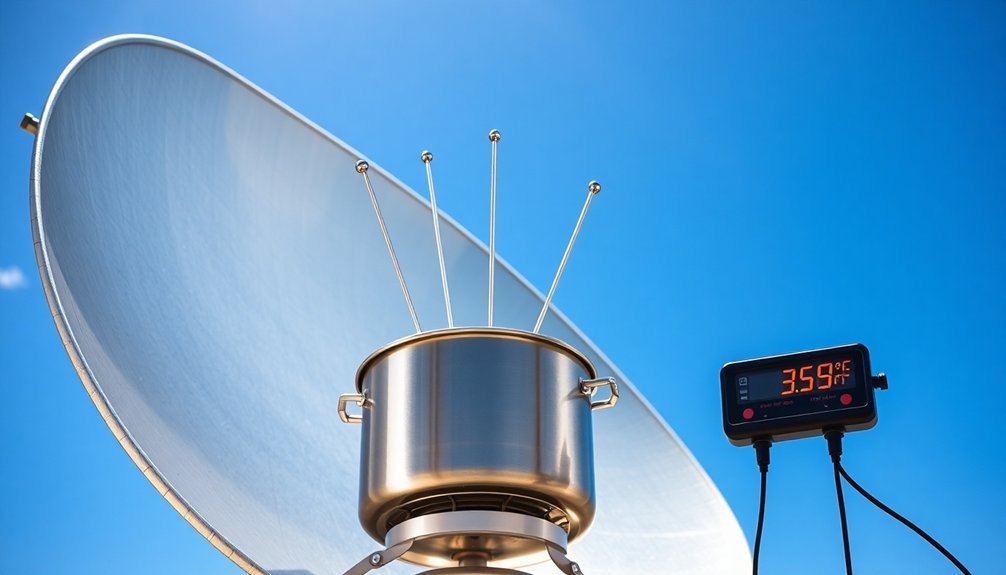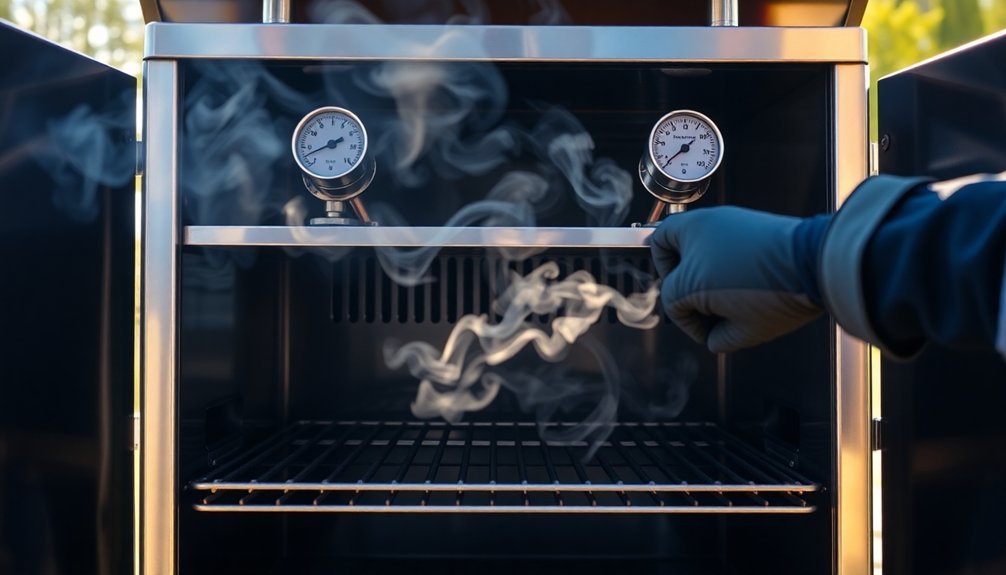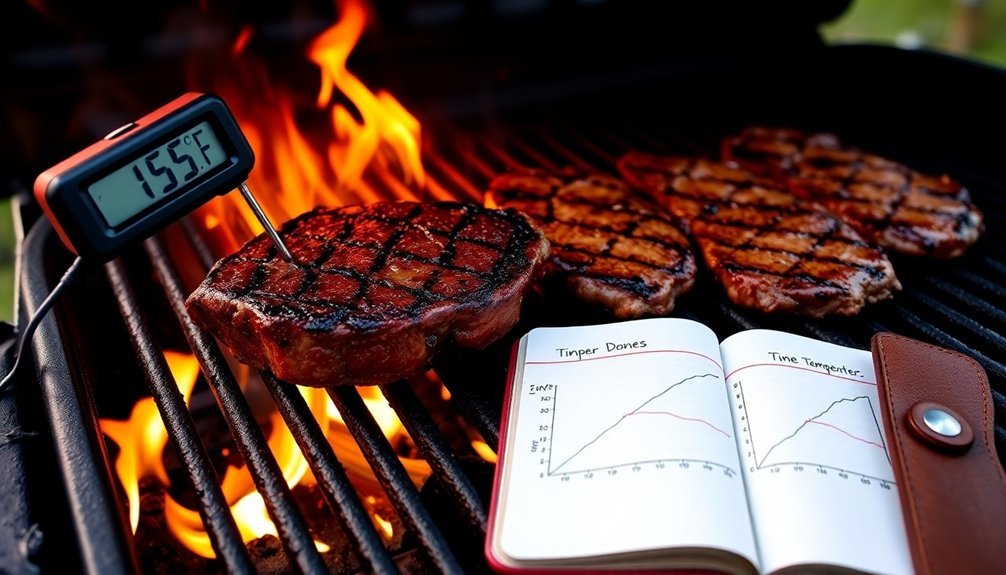You'll gain better control over outdoor cooking temperatures by implementing these five proven methods. Position your solar reflectors at ideal angles (around 15.5° for lower sun positions) and rotate regularly for consistent heat. Choose dark-colored cookware, especially cast iron, to maximize heat absorption and retention. Install proper ventilation systems with at least 1200 CFM fan power to manage airflow and temperature. Use high thermal mass materials like brick or stone to maintain steady temperatures. For precise cooking times, adjust your recipe duration based on actual versus target temperatures – these techniques will enhance your outdoor cooking mastery.
Solar Reflector Positioning

When setting up a solar cooker, proper reflector positioning plays an essential role in maximizing cooking efficiency.
You'll need to adjust your reflector's angle to match the sun's altitude, with a tilt of approximately 15.5° offering ideal radiation gains at lower angles. Make sure the reflector doesn't block direct sunlight to the cooking area. Using a dark-colored pot will significantly improve heat absorption during cooking.
To maintain consistent temperatures, you'll want to track the sun's movement.
Rotate your box-style cooker every 20 minutes or parabolic cooker every 10 minutes. You can use a stick or tape to prop the reflector at the right angle. For precise control, consider installing a sun tracking mechanism.
Remember to account for your location's latitude and seasonal changes when positioning your reflector.
This guarantees you're capturing maximum sunlight throughout the year.
Dark Cookware Selection
Since dark cookware absorbs heat more effectively, selecting the right equipment can greatly impact your outdoor cooking success.
Cast iron skillets, particularly traditional and enameled versions, offer superior heat retention and distribution for outdoor cooking environments. Some brands provide lighter weight options while maintaining durability and performance. You'll find these versatile pieces work well with multiple heat sources, from charcoal to wood coals.
When choosing dark cookware for outdoor cooking, consider these essential factors:
- Heat retention capabilities – cast iron maintains consistent temperatures for even cooking
- Durability requirements – thick cast iron construction withstands outdoor elements
- Maintenance needs – enameled options require less upkeep than traditional cast iron
- Weight considerations – lightweight cast iron alternatives offer easier handling while maintaining heat performance
Select pieces that match your specific outdoor cooking style and portability needs.
Cooking Chamber Ventilation

Proper cooking chamber ventilation complements your dark cookware selection by guaranteeing ideal temperature control and smoke management in outdoor cooking spaces. High-velocity models are ideal choices for maximizing ventilation effectiveness. You'll need a hood that's larger than your grill with at least 1200 CFM fan power. Position it close to the cooking surface while guaranteeing proper clearance per manufacturer specs.
| Feature | Benefit | Impact |
|---|---|---|
| Cross-Ventilation | Natural airflow management | Keeps you comfortable while cooking |
| Grease Filters | Smoke and odor reduction | Creates a cleaner cooking environment |
| Insulated Jackets | Heat containment | Protects your investment and guarantees safety |
Consider your climate when designing ventilation. In hot weather, you'll want overhead vents to draw heat upward, while in dry conditions, you'll need to account for unique airflow dynamics. Don't forget to maintain your system regularly for peak performance.
Heat Retention Materials
Choosing the right heat retention materials can greatly impact your outdoor cooking results.
You'll find that materials with high thermal mass like brick, stone, and cast iron provide consistent temperatures, while proper insulation methods help maintain heat efficiency.
For outdoor cooking setups, double-skinning and thermal blankets can considerably reduce fuel consumption.
- Use cast iron cooking surfaces for even heat distribution and superior retention during long cooking sessions.
- Install firebricks in pizza ovens and BBQ floors to stabilize temperatures.
- Add a water pan to your BBQ kettle for improved temperature stability.
- Consider ceramic materials for their excellent heat-storing capabilities.
When selecting heat transfer materials, remember that thicker metals maintain steadier temperatures, though they'll take longer to heat initially.
For best results, combine high thermal mass materials with proper insulation techniques.
Time-Based Temperature Adjustments

Making accurate time-based temperature adjustments is crucial for successful outdoor cooking. You'll need to calculate the percentage difference between your target and actual temperatures to adjust cooking times correctly. For example, if you're cooking at 400°F instead of the recommended 450°F, multiply your cooking time by 0.89 to get the adjusted duration.
When cooking outdoors, you'll face additional variables that affect temperature control. Wind can greatly impact your grill's temperature, so you'll want to monitor it constantly with a reliable thermometer.
Keep track of how quickly your food's temperature rises and adjust your estimated completion time accordingly. Remember to account for heat loss when opening the grill lid and maintain proper spacing between food items for even cooking.
Frequently Asked Questions
How Do Digital Temperature Controllers Affect Charcoal Grill Performance?
Digital controllers boost your grill's performance by automating airflow and temperature. You'll get precise heat control, consistent cooking temps, and smart features like auto-recovery after lid openings and remote monitoring through apps.
Can Different Types of Wood Chunks Impact Temperature Control?
Yes, your wood choice greatly affects temperature control. You'll find that dense woods like hickory burn hotter and longer, while milder woods like oak burn cooler and steadier, requiring different vent adjustments.
Does Altitude Affect Charcoal Grill Temperature Management?
Yes, altitude will affect your charcoal grill's temperature. You'll need to adjust vents more carefully, use less charcoal, and expect longer cooking times since lower air pressure impacts heat generation and maintenance.
How Does Humidity Influence Temperature Stability in Outdoor Grilling?
You'll notice humidity slows moisture evaporation from your food's surface, leading to faster cooking times. In humid conditions, you'll need to monitor temperatures closely and adjust your vents to maintain stable grilling temperatures.
What Role Do Grill Grates' Material Play in Maintaining Cooking Temperatures?
Your grill grates' aluminum material efficiently conducts and distributes heat, maintaining stable temperatures. The raised rail design traps heat beneath food, while hard anodization creates a non-stick surface that retains consistent cooking temperatures.
In Summary
You'll find these five temperature control methods essential for mastering outdoor cooking. By combining proper solar reflector angles, dark-colored pots and pans, strategic ventilation, insulating materials, and careful timing adjustments, you're now equipped to maintain ideal cooking temperatures in any outdoor setting. Put these techniques into practice, and you'll transform your outdoor cooking from unpredictable to consistently successful.





Leave a Reply